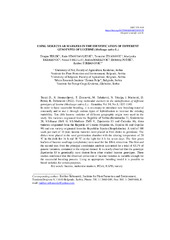Приказ основних података о документу
Using molecular markers in the identification of different genotypes of lucerne (Medicago sativa L.)
| dc.creator | Terzic, Dragan | |
| dc.creator | Stanisavljević, Rade | |
| dc.creator | Živanović, Tomislav | |
| dc.creator | Tabaković, Marijenka | |
| dc.creator | Trkulja, Nenad | |
| dc.creator | Marković, Jordan | |
| dc.creator | Poštić, Dobrivoj | |
| dc.creator | Štrbanović, Ratibor | |
| dc.date.accessioned | 2023-07-12T19:10:37Z | |
| dc.date.available | 2023-07-12T19:10:37Z | |
| dc.date.issued | 2022 | |
| dc.identifier.issn | 0534-0012 | |
| dc.identifier.issn | 1820-6069 | |
| dc.identifier.uri | https://plantarum.izbis.bg.ac.rs/handle/123456789/670 | |
| dc.description.abstract | In order to have successful breeding, it is necessary to introduce new breeding material constantly and to use it through various types of hybridisation to increase the existing variability. Ten (10) lucerne varieties of different geographic origin were used in the study. Six varieties originated from the Republic of Serbia (Kruševačka 22, Kruševačka 28, NS-Banat ZMS II, NS-Mediana ZMS V, Zaječarska 83 and Čačanka 10), three varieties originated from the Republic of Croatia (Osječka 66, Osječka 88 and Osječka 99) and one variety originated from the Republika Srpska (Banjalučanka). A total of 100 seeds per each of 10 (ten) lucerne varieties were placed in Petri dishes to germinate. The dishes were placed in the seed germination chamber with the altering temperature of 20 oС in the dark for 16 h and 30 oС in the light for 8 h for seven days. The first green leaflets of lucerne seedlings (cotyledons) were used for the DNA extraction. The first and the second axes from the principal coordinates analysis accounted for a total of 63.1% of genetic variation, contained in the original dataset. It is clearly observed that the genotype Zaječarska 83 is genetically most distant from other studied lucerne genotypes. These studies confirmed that the observed collection of lucerne varieties is variable enough for the successful breeding process. Using an appropriate breeding model it is possible to breed varieties for certain purposes. | sr |
| dc.language.iso | en | sr |
| dc.publisher | Društvo genetičara Srbije | sr |
| dc.relation | info:eu-repo/grantAgreement/MESTD/inst-2020/200010/RS// | sr |
| dc.relation | info:eu-repo/grantAgreement/MESTD/inst-2020/200040/RS// | sr |
| dc.relation | info:eu-repo/grantAgreement/MESTD/inst-2020/200217/RS// | sr |
| dc.relation | info:eu-repo/grantAgreement/MESTD/inst-2020/200383/RS// | sr |
| dc.rights | openAccess | sr |
| dc.rights.uri | https://creativecommons.org/licenses/by-nc-nd/4.0/ | |
| dc.source | Genetika | sr |
| dc.subject | lucerne | sr |
| dc.subject | molecular markers | sr |
| dc.subject | PCoA | sr |
| dc.subject | RAPD | sr |
| dc.subject | variety | sr |
| dc.title | Using molecular markers in the identification of different genotypes of lucerne (Medicago sativa L.) | sr |
| dc.type | article | sr |
| dc.rights.license | BY-NC-ND | sr |
| dc.citation.epage | 1169 | |
| dc.citation.issue | 3 | |
| dc.citation.rank | M23 | |
| dc.citation.spage | 1157 | |
| dc.citation.volume | 54 | |
| dc.type.version | publishedVersion | sr |
| dc.identifier.doi | https://doi.org/10.2298/GENSR2203157T | |
| dc.identifier.fulltext | http://plantarum.izbis.bg.ac.rs/bitstream/id/2808/bitstream_2808.pdf | |
| dc.identifier.scopus | 2-s2.0-85148588312 |


